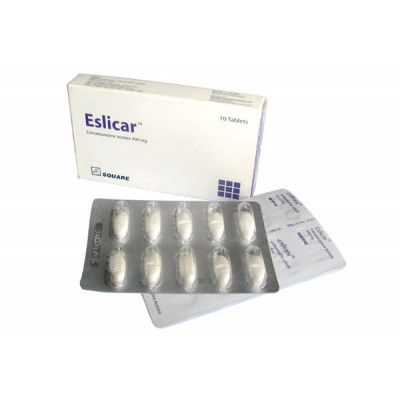
Type:Tablet
Generic Name:Eslicarbazepine
Manufacturer:Square Pharmaceuticals PLC.
Price:৳35.11
Partial-onset seizures
May take with or without food
Partial-Onset Seizures Indicated for partial-onset seizures as monotherapy or adjunctive therapy Initial 400 mg PO qDay For some patients, treatment may be initiated at 800 mg qDay if the need for additional seizure reduction outweighs an increased risk of adverse reactions during initiation Titration & maintenance Increase dose by weekly increments of 400-600 mg, based on clinical response and tolerability Recommended maintenance dose is 800-1600 mg once daily Monotherapy: Consider 800 mg/day maintenance dose in patients unable to tolerate 1200 mg/day Adjunctive therapy: 1600 mg/day should be considered in patients who did not achieve a satisfactory response with 1200 mg/day Hepatic impairment Mild-to-moderate: No dosage adjustment required Severe: Not recommended (not studied)
<18 years: Safety and efficacy not established
Renal impairment Moderate-to-severe (CrCl <50 mL/min): Reduce the initial, titration, and maintenance doses by 50%; may adjust titration and maintenance doses according to clinical response
Hypersensitivity to the active substance, to other carboxamide derivatives (e.g. carbamazepine, oxcarbazepine) or to any of the excipients. Second or third degree atrioventricular (AV) block.
Antiepileptic drug; eslicarbazepine acetate is a prodrug that is activated to eslicarbazepine (S-licarbazepine), the major active metabolite of oxcarbazepine. Stabilizes neuronal membranes by blocking Na+ channels; this may inhibit repetitive firing and may decrease the propagation of synaptic impulses; may also increase potassium conductance and modulate the activity of high-voltage activated calcium channels.
Suicidal ideation Suicidal ideation and behaviour have been reported in patients treated with anti-epileptic active substances in several indications. A meta-analysis of randomised placebo-controlled trials of anti-epileptic medicinal products has also shown a small increased risk of suicidal ideation and behaviour. Therefore, patients should be monitored for signs of suicidal ideation and behaviours and appropriate treatment should be considered. Patients (and caregivers of patients) should be advised to seek medical advice should signs of suicidal ideation or behaviour emerge. Nervous system disorders Eslicarbazepine acetate has been associated with some central nervous system adverse reactions, such as dizziness and somnolence, which could increase the occurrence of accidental injury. Oral contraceptives Eslicarbazepine acetate may decrease the effectiveness of hormonal contraceptives. Additional non-hormonal forms of contraception are recommended Other warnings and precautions If Eslicarbazepine is to be discontinued it is recommended to withdraw it gradually to minimise the potential of increased seizure frequency. Concomitant use of eslicarbazepine acetate with oxcarbazepine is not recommended because this may cause overexposure to the active metabolites. Hyponatraemia Hyponatraemia has been reported as an adverse reaction in 1.2% of patients treated with Eslicarbazepine. Hyponatraemia is asymptomatic in most cases, however, it may be accompanied by clinical symptoms like worsening of seizures, confusion, decreased consciousness. Frequency of hyponatraemia increased with increasing eslicarbazepine acetate dose. In patients with pre-existing renal disease leading to hyponatraemia, or in patients concomitantly treated with medicinal products which may themselves lead to hyponatraemia (e.g. diuretics, desmopressin, carbamazepine), serum sodium levels should be examined before and during treatment with eslicarbazepine acetate. Furthermore, serum sodium levels should be determined if clinical signs of hyponatraemia occur. Apart from this, sodium levels should be determined during routine laboratory examination. If clinically-relevant hyponatraemia develops, eslicarbazepine acetate should be discontinued. PR interval Prolongations in PR interval have been observed in clinical studies with eslicarbazepine acetate. Caution should be exercised in patients with medical conditions (e.g. low levels of thyroxine, cardiac conduction abnormalities), or when taking concomitant medicinal products known to be associated with PR prolongation. Lactation: Unknown if distributed in human breast milk
>10% Dizziness (20-28%),Somnolence (11-18%),Nausea (10-16%),Headache (13-15%),Diplopia (9-11%) 1-10% Vomiting (6-10%),Fatigue (4-7%),Blurred vision (5-6%),Ataxia (4-6%),Vertigo (2-6%),Diarrhea (2-4%),Tremor (2-4%),Balance disorder (3%),Asthenia (2-3%),Falls (1-3%),Depression (1-3%),Rash (1-3%),Constipation (2%),Abdominal pain (2%),Gait disturbance (2%),UTI (2%),Hyponatremia (2%),Insomnia (2%),Visual impairment (1-2%),Gastritis (1-2%),Peripheral edema (1-2%),Dysarthria (1-2%),Memory impairment (1-2%),Nystagmus (1-2%),Cough (1-2%),Hypertension (1-2%)
Pregnancy Limited available data with eslicarbazepine acetate use in pregnant women are insufficient to inform a drug-associated risk of adverse developmental outcomes Advise women of reproductive potential taking eslicarbazepine acetate who are using a contraceptive containing ethinylestradiol or levonorgestrel to use additional or alternative non-hormonal birth control Eslicarbazepine acetate was evaluated in rats and mice for potential adverse impact on fertility of the parental and first generation Lactation Eslicarbazepine is present in human milk; effects of eslicarbazepine acetate on the breastfed infant or on milk production are unknown